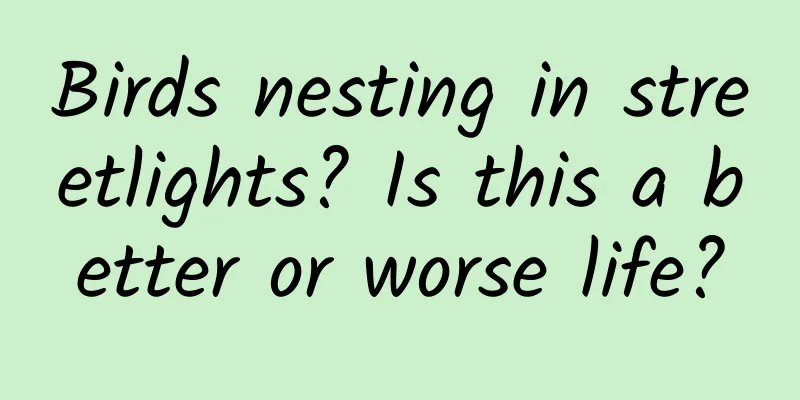Birds nesting in streetlights? Is this a better or worse life?

|
This is a street lamp in Shenzhen Futian Mangrove Ecological Park, with a great tit in the vent. It is not stuck, it is just going home - there is a nest in the lamp post . A great tit trying to get into a lamp post. This is an old street lamp in the park. At the end of last year, they replaced it with a batch of new street lamps that are more suitable for birds to nest. | Photo provided by the interviewee There are many street lamps with bird nests in the park. The ecological park is located in Futian District, Shenzhen. It is only 38 hectares in size and can be visited in less than half an hour. To the north of the park are the busy residential areas of Shawei and Shixia. People nearby come here every day to take a walk, cool off, and play badminton. This inconspicuous street park, located in the city center, does not seem to be suitable for wild animals to survive - but in the past two years, it has been featured in academic journals several times for its biodiversity conservation . Bird killers in ecological parks The park was in the news a few years ago because of otters. Futian Mangrove Ecological Park has a special geographical location. To the north is a residential area, to the west is the Futian Mangrove National Nature Reserve, and to the south is Hong Kong's Mai Po Nature Reserve across a river. Originally a dock and plantation, the government began to transform it into an ecological park in 2012. The park is divided into three areas: public tour area, conservation and restoration area, and ecological control area. The public tour area and conservation and restoration area are open to the public, while the ecological control area is open by appointment. The geographical location of the ecological park|shenchuang.com On October 25, 2020, an infrared camera in the southern area of the park captured an otter, and conservationists later found otter feces . This is the first time in more than 20 years that otter activity has been recorded in Shenzhen. Previously, leopard cats and small civets had also appeared in the park, making it look like a pure land for wild animals in the city. Otter images captured by infrared cameras|Mangrove Foundation But not every place here is suitable for animals to live in. For example, the glass of the science exhibition hall killed eight birds in one year. The Science and Technology Exhibition Hall is located in the northern area of the park. It is a 6-meter-high curved building with glass curtain walls on both sides: the convex curtain wall faces the visitor square with a mainly concrete floor, and the concave curtain wall faces the small garden in the office area. In 2019, when the science exhibition hall was first put into use, the cleaning staff found the dead body of a bird under the concave glass curtain wall . "Little Volcano", the conservation director of the Mangrove Wetland Conservation Foundation, quickly realized that it was a bird strike. Bird strikes refer to the phenomenon of birds being injured or killed after colliding with man-made facilities such as buildings. In cities, glass on building exteriors is the main cause of bird strikes : on the one hand, birds see habitats or the sky reflected on the glass (such as a small garden reflected on concave glass) and mistakenly believe that they can reach these locations on the glass; on the other hand, birds may ignore the transparent glass and mistakenly believe that they can directly reach the other side. It is estimated that bird strikes kill up to 25 million birds each year in Canada, and in the United States, the figure may reach a staggering 365 million to 988 million. Bird strikes have become the second largest anthropogenic cause of bird mortality in North America, second only to stray cats killing birds. The Mangrove Foundation is responsible for the actual management and operation of the ecological park, and Huoshan and his colleagues work in the park. They asked the cleaning and security personnel in the park to pay attention to bird strikes near the exhibition hall when patrolling. Starting from October 2019, in a year, they recorded only one bird strike on the convex glass curtain wall, but recorded 11 on the concave glass curtain wall, including 8 deaths . Bird strikes recorded on both sides of the Science and Technology Exhibition Hall (the curved building in the picture) | Reference [1] According to statistics, there are more than 200 bird species in Futian Mangrove Ecological Park, including black-faced spoonbills, white-shouldered eagles, yellow-breasted buntings and other national first-class protected animals. Shenzhen is located at the midpoint of the East Asian-Australasian bird migration area, and a large number of migratory birds pass through here every autumn to their wintering grounds. More than half of the bird strikes they recorded in the park occurred in autumn. Fortunately, research on bird strikes was carried out early abroad, and there are relatively mature solutions for preventing bird strikes: as long as stickers are affixed on the glass curtain wall, the occurrence of bird strikes can be effectively reduced. In October 2020, they pasted dot stickers on the concave curtain wall of the science exhibition hall; for aesthetic reasons, they also pasted animal stickers with images of common animals in the park. In the following two years, the number of bird strikes on the concave glass curtain wall decreased to 2 per year. Just simple stickers can effectively reduce the frequency of bird strikes. The exterior wall of the science exhibition hall is covered with anti-bird collision stickers|References[1] In the process of urbanization, when the habitats of animals disappear and reinforced concrete buildings are erected, animals have to face many unfamiliar challenges. Bird strikes are a problem that animals face in urbanization - they cannot adapt to glass, a new thing that does not exist in nature, and cannot distinguish the green space that cannot be reached behind transparent glass. In this case, urbanization will cause them harm or even death. In other cases, animals seem to have adapted to the city and successfully found a place to live in the man-made environment; but this may end up putting themselves in new predicaments - such as the bird that built a nest in the street lamp mentioned at the beginning. Birds nesting in street lamps In the spring of 2020, Huoshan was patrolling the park when he saw a great tit carrying hay in its beak and flying into the vent of a street lamp post. Could it be that they were building nests in the street lamps? He and his colleagues checked all 190 street lamps in the park and indeed found 14 nests of great tits . The great tit, Parus minor, is small enough to fit into the hole. Reference [2] Living in a street lamp - this seems a little outrageous, but it seems reasonable when applied to great tits. The tit family does well in cities. As early as 100 years ago, people found that tits in cities can open bottle caps and drink milk. Previous studies have also found that the Eurasian great tit, which is closely related to the great tit, will adjust its singing to adapt to the noisy and changeable cities; it will also change its breeding time and nesting materials according to the urban environment. Previously, people have also found great tits nesting in lampposts. It might seem like great tits have adapted to city life and are able to use human infrastructure to their advantage, but in reality, these lampposts are not ideal nesting sites. Great tits build nests and lay eggs in lamp posts | Reference [2] Although street lamps keep great tits away from predators such as snakes and rodents, they also bring them closer to pedestrians and make them more easily disturbed by human activities. Past studies have found that human activities reduce the reproductive success rate of great tits. What's more, the lamp posts in the park are hollow inside , and the great tits stuff grass, moss, kapok wool and other nesting materials between the wires and the inner wall of the lamp posts. At a height of more than 2 meters above the ground, these materials are very easy to fall. This will prevent the great tits from successfully building nests and may also cause them to fail to reproduce. In addition, the street lamps in the park are prone to short circuits in the spring, which is also related to the falling of nesting materials. From 2020 to 2022, they recorded a total of 43 great tit nests, but only 21 of them were successful in the end , with a success rate of less than 50%, which is lower than their reproduction rate in previous studies. Of the 22 nests that failed to reproduce, 9 were due to nest drop, accounting for as high as 41%. For great tits, lamp posts seem to be far away from predators and are a good choice for nesting in the city, but in fact they are an ecological trap. Huoshan decided to help the tits. There are many trees in the park, and they prepared nest boxes for the great tits. There are wooden boards at the bottom of the nest boxes, which can at least ensure that the bird nests will not fall. Unexpectedly, two years later, the great tits did not appreciate this "for your own good" approach - they did not like any nest boxes and continued to drill into the street lamps. Nest boxes built for great tits. They don't live in nest boxes, perhaps because the trees in the park are too new, or because they prefer to rely on experience and like to build nests and reproduce in old nests. There was no other way, since great tits had a special liking for lampposts, they had to find a way to make them more "livable". So they designed a new street light that can provide a nesting environment for birds . New street lights are combined with nest boxes | Photo provided by the interviewee Nest boxes are installed on the back of the new street lamp posts to prevent bird nests from falling. Cameras are also installed in the nest boxes so that researchers can observe their conditions at any time. The holes for birds to enter and exit have also been moved from the side of the street lamp to the back to reduce human interference. Not only great tits but also larger magpie robins nest in the lamp posts, so they designed holes of different sizes in the hope that the two common hole-nesting birds in the park can move in. In addition to being more livable, the new street lights are also friendlier to other creatures and the natural environment . The light from the new street lights is concentrated on the pedestrian path, reducing the interference of light to animals on the lawn. The light is also softer, and according to the standards of the International Dark Sky Community, the color temperature is set to no higher than 3000k to reduce light pollution in the night sky; the wavelength is set to 590nm to reduce the impact on fireflies. The lighting after the renovation is softer and has less impact on the lawn and trees. | Photo provided by the interviewee There are many springs The reason why these conservation efforts take place here is inseparable from the particularity of the park itself. From a geographical point of view, Futian Mangrove Ecological Park is a transition zone from a bustling city to a nature reserve. It is located next to Shenzhen Bay together with Futian Mangrove Nature Reserve and Hong Kong Mai Po Nature Reserve. Its ecological value may attract more attention than other city parks. From the perspective of operation mechanism , the park is actually operated by the Mangrove Foundation, a non-governmental environmental protection organization dedicated to wetland and biodiversity protection. This allows the park to provide citizens with a place to rest and play while also receiving more professional natural protection. Black-faced spoonbills are also a star species in the park. They come here to spend the winter every year, over and over again|meeb.sz.gov.cn Uncivilized behavior in the park also bothered Huoshan. He had seen tourists releasing animals, feeding fish, and digging wild vegetables in the park. To this end, the park set up science popularization signs, held nature education activities, and staff and volunteers would also stop uncivilized behavior when patrolling the park. On the other hand, these conservation activities in the park cannot be separated from the participation of the public . For example, when investigating the nesting of birds in lamp posts, the lamp posts have to be recorded every two days, and the selfie stick needs to be used to put the mobile phone into the street lamp to take pictures. The workload of 190 street lamps is not small, and it can only be completed smoothly by volunteers. Many volunteers are nearby residents. They may just come to the park to stroll and rest at first, but as they get to know each other better, they eventually become an indispensable conservation force. Most volunteers are women, who are an important force in citizen science | Photo provided by the interviewee How can we better coexist with wildlife during the process of urbanization? Futian Mangrove Ecological Park may not be able to give a complete answer to this question, after all, a city is much larger and more complex than a park. But the exploration of urbanization conducted by humans and animals here may provide more perspectives and experiences for urban biodiversity conservation. However, in Huoshan's view, "urban biodiversity protection is a long-term task." What he is doing now is just the beginning. At the beginning of this year, they replaced the anti-bird-strike stickers with new ones . Previously, the spacing between the dots was 6.5 cm up and down and 10 cm left and right. Although it significantly reduced the number of bird strikes, it could not completely prevent bird strikes. This time, they shortened the spacing between the stickers to 5 cm, which is also a more common specification internationally. Replaced with new stickers | Photo provided by the interviewee Since the stickers were replaced, there has not been a single bird strike in the park. But the migration season has just begun, and the effectiveness of the new stickers will only be truly verified this fall. As for his beloved street lamps, the new batch of street lamps were officially put into use at the end of last year. This spring, the street lamps welcomed the first batch of residents, but unfortunately the occupancy rate was not ideal - the great tits seemed to be not used to the new house and went to build nests in the old lamp posts next door. In the end, only a pair of magpie robins chose the new lamp posts. The only resident of the new lamppost | Photo provided by the interviewee But this is just the beginning. Huoshan thinks that when the next breeding season comes next spring, the new street lights may be accepted by more birds. At the end of September, after two typhoons had passed, he saw a magpie robin with a ring on its foot in the park. It was a chick born in the park this spring, and now, half a year later, it has become an adult. A baby magpie robin born in the park this spring | Photo provided by the interviewee In this small park, people walk, rest, and spend their leisure time in daily life. Animals also come and go here, encounter death here, and welcome new life here. Next spring, maybe there will be better stories here. References [1] Rong Canzhong, Xie Kaiqi, Yin Yuzhu. 2024. Preliminary practice of bird strike prevention in urban parks. Journal of Zoology, 59(4): 520-526. [2] Rong Canzhong, Zhu Lei, Yin Yuzhu, Xie Kaiqi. 2023. Reproductive ecology of great tits on lampposts in Shenzhen city parks. Journal of Zoology, 58(4): 505-513. Author: Mai Mai Edited by: Yellowtail Pollock This article comes from GuokrNature (ID: GuokrNature) |
<<: Where does carbon come from? Ancient plants that look like chocolate cones give the answer →
>>: Weighing more than two pigs! How was this champion giant pumpkin grown?
Recommend
If the whole of China was a class, Yunnan would definitely be the representative of biology class!
...
The Olympic events patted you on the back. It turns out there are so many Olympic events that you can practice in your daily life!
Review expert: Peng Guoqiu, deputy chief physicia...
〔2021 Summer〕Senior 3 Chemistry Target A+ Jia Shizeng
〔2021 Summer〕High School Chemistry Target A+ Jia ...
Simple-side-drawer implements the side menu
introduce Implement the drawer view (slide out me...
Wearable devices: Has the war among giants begun?
On March 25, the three IT giants Intel, Google an...
4 elements + 5 tricks, you can leverage Father’s Day marketing to be full of dad spirit!
In holiday marketing, we should take into account...
Is the perfect world of IoT secure enough?
Introduction: Security challenges are increasing ...
Babao Compound Interest Academy·Newbie Wealth Training Camp Course
Course Format: WeChat community interactive mode,...
Does the blackening of silver jewelry mean that the body is detoxifying? Stop kidding! The real reason is this
Produced by: Science Popularization China Produce...
If your organs could talk, how would you be scolded every day?
Review | Li Nannan Director of Hunan Science Writ...
Want to bring the rainforest home? Here's what you need to do
The tropical rainforest is the most species-rich ...
How to write good copy? (I)
The author of this article will combine relevant ...
He may have drawn more pictures than you have walked.
Although he is over 90 years old, Chen Yu, former...
How to promote and attract traffic to Douyin store?
Many merchants who sell things on Douyin have ope...
How many points are required for admission to Wuhan University? How many points do I need in the 2020 Hubei College Entrance Examination to apply for Wuhan University?
On the afternoon of July 23, admissions officers ...









